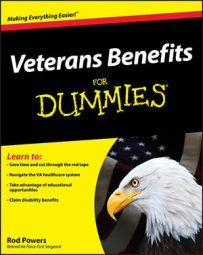Veterans benefits available to you vary based on the type of your military service, so it's important to understand the differences before you apply for any veterans benefits. As you'll see, military service varies from full-time warriors to various types of reservists.
Veterans benefits and full-time warriors
Active-duty service is full-time service. This is generally what most people think of when someone says he was in the military. Except when on leave (vacation) or pass (authorized time off), active-duty members are subject to duty 24 hours per day, 7 days per week. Think of it as a full-time job.
These folks serve in the Army, Air Force, Navy, Marine Corps, and Coast Guard. These military branches fall under the direction of the U.S. Department of Defense.
Active-duty service counts toward length-of-service requirements when qualifying for veterans benefits.
Veterans benefits and weekend warriors
Members of the Reserves and National Guard normally perform duty one weekend per month, plus two weeks of training per year.
It’s actually not fair to refer to them as weekend warriors anymore. Ever since the United States jumped onto the sand with both feet during the first Gulf War in 1990, these warriors have been spending more and more time called to full-time active duty in support of contingency operations.
The average National Guard or Reserve enlistment contract is for six years. These days, a Guard or Reserve member can expect to spend about two years of that six-year enlistment period performing full-time active duty.
Veterans benefits and the Reserves
Each of the military services has a Reserve branch. There’s an Army Reserve, Air Force Reserve, Navy Reserve, Marine Corps Reserve, and Coast Guard Reserve. Like the active-duty forces, the Reserves fall under the auspices of the Department of Defense, so they are federal agencies. The primary purpose of the Reserves is to provide additional support and manpower to the active-duty forces in times of need.
When you join the Reserves, you first attend basic training and military job school full time. This is called active duty for training, or ADT, and doesn’t count as active-duty time for most veterans benefits.
Upon completion of basic training and military job school, reservists return to their home, resume their lives and normal civilian jobs, but train (drill) with their unit one weekend per month. Once per year, they receive 14 days of full-time training.
The weekend drills are called inactive duty training (IDT), and the annual training falls into the category of ADT. Neither IDT nor ADT counts toward service requirements for veterans benefits.
The president and the secretary of defense can recall reservists to active duty at any time to support military missions. In fact, at any given time, about 65,000 reservists are performing active duty in support of military contingency operations. Active duty of this type does count toward veterans benefit service requirements.
Veterans benefits and the National Guard
There are only two National Guard services: the Army National Guard and the Air National Guard. The Navy, Marine Corps, and Coast Guard don’t have National Guard branches.
The main difference between the National Guard and the Reserves is that the Reserves belong to the federal government, while the National Guard units belong (primarily) to the individual states.
Like reservists, National Guard members attend basic training and military job school full time under ADT (active duty for training). They then return to their homes, where they drill with their units one weekend per month (inactive duty training [IDT]), plus 15 full-time training days per year. As with Reserve duty, this ADT/IDT time doesn’t count toward veterans benefit service requirements.
State governors can call National Guard members to active duty in response to state emergencies, such as disaster relief or protection of property and people, when it’s beyond the scope of local law enforcement agencies. This is officially known as a “Title 38 Call-up,” and is commonly referred to as state duty. State duty doesn’t count toward veterans benefit service requirements.
National Guard members can also be called to active duty by the president or secretary of defense in support of military contingency operations. This is called “Title 10 Call-up,” or federal duty. This type of duty does count toward service requirements for veterans benefits. During any given month, about 40,000 members of the Air and Army National Guard are performing federal duty in such garden spots as Afghanistan and Iraq.
Veterans benefits and Active Guard/Reserves
Some members of the Reserves and National Guard perform full-time active duty, just like active-duty members. This program is called the Active Guard/Reserves, or AGR. AGR members provide day-to-day operational support needed to ensure that National Guard and Reserve units are ready to mobilize when needed. For veterans benefit service requirements, AGR duty is the same as full-time active-duty service.
Veterans benefits and Individual Ready Reserve
It may surprise you to find out that everyone who joins the U.S. military for the first time incurs a minimum eight-year military service obligation. Yep. When you sign that enlistment contract, you’re obligating yourself to the military for a total of eight years. Whatever time isn’t spent on active duty or in the Guard/Reserves must be spent in the inactive reserves, officially known as the Individual Ready Reserves (IRR).
Say you enlist in the Navy for four years. You serve your four years and get out. You’re really not “out.” You’re transferred to the IRR for the next four years.
Members of the IRR don’t perform weekend drills or annual training, and they don’t get paid. However, IRR members can be recalled to active duty at any time in support of military operations. Time in the IRR doesn’t count toward veterans benefit service requirements, but if you’re recalled to active duty, that time does count.
An average of about 15,000 IRR members have been recalled to active duty each and every year since 2004, the vast majority by the Army and Marine Corps.

